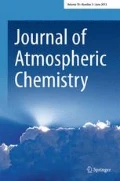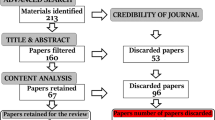Abstract
The flux of CH4 and CO2 from termite nests into the atmosphere has been measured in a broad-leafed-type savannah in South Africa. Measurements were carried out on nests of species of six genera, i.e., Hodotermes, Macrotermes, Odontotermes, Trinervitermes, Cubitermes, and Amitermes. The flux rates of CH4 relative to the flux rate of CO2 in terms of carbon obtained for the individual species showed ratios of 2.9×10-3, 7.0×10-4, 6.7×10-5, 8.7×10-3, 2.0×10-3 and 4.2×10-3, respectively. Using data published on the assimulation efficiencies of termites, the flux of carbon as CH4 accounts for 6.0×10-5 to 2.6×10-3 of the carbon ingested which results in a global CH4 emission by termites of 2 to 5×1012 g/yr. Methane is decomposed in the soil with average decomposition rates of 52 μg/m2/h. The annual CH4 consumption in the tropics and subtropics is estimated to be 21×1012 g which exceeds the CH4 emission rate by termites.
Similar content being viewed by others
References
Breznak J. A., 1975, Symbiotic relationships between termites and their intestinal microbiota, in Symbiosis, Cambridge University Press, London, pp. 559–580.
Breznak J. A., 1982, Intestinal microbiota of termites and other xylophageous insects, Ann. Rev. Microbiol. 32, 323–343.
Collins N. M., 1981, The role of termites in decomposition of wood and leaf litter in southern Guinea savanna of Nigeria, Oecologia (Berlin) 51, 389–399.
Collins N. M., 1982, The importance of being a bugga-bug, New Scientist 24, 834–839.
Collins N. M., 1983, Termite (Isoptera) populations and their role in litter removal in Malaysian rain forests, in S. L. Sutton, T. C. Whitmore and A. C. Chadwik (eds.), Tropical Rain Forests: Ecology and Management, Blackwell, oxford.
Collins, N. M. and Wood, T. G., 1983, Termites and atmospheric gas production, accepted for publication in Science.
Cook S. F., 1932, The respiratory gas exchange in Termopsis nevadensis, Biological Bulletin, Marine Biological Laboratory, Woods Hole, 63, 246–257.
Crutzen P., 1982, The global distribution of hydroxyl, in E. D. Goldberg (ed.), Atmospheric Chemistry, Springer-Verlag, Berlin, 313–328.
Ferrar P., 1982, Termites of a South African savanna, Oecologia, Berlin 52, 125–151.
Hébrant F., 1970, Circadian rhythm of respiratory metabolism in whole colonies of the termite, Cubitermes exiguus, J. Insect Physiol. 16, 1229–1235.
Josens, G., 1972, Etudes biologiques et écologiques des termites (Isoptera) de la Savane de Lamto-Pakobo (Cote d'Ivoire), PhD thesis, University of Brussels.
Josens G., 1973, Observations sur les brilans énergétiques dans deux populations de termites à Lamto (Cote d'Ivoire), Annales de la Société royale zoologique de Belgique 10, 169–176.
Khalil M. A. K. and Rasmussen R. A., 1983, Reply to ‘Termites and methane’ by Zimmerman and Greenberg, Nature 302, 355.
Khalil M. A. K. and Rasmussen R. A., 1983, Sources, sinks, and seasonal cycles of atmospheric methane. J. Geophys. Res. 88, 5131–5144.
Lee K. E. and Wood T. G., 1971a, Physical and chemical effects on soils of some Australian termites and their pedological significance, Pedobiologia II, 876–409.
Lee K. E. and Wood T. G., 1971b, Termite and Soils, Academic Press, New York, London.
Lepage M., 1974a, Recherches écologiques sur une savane sahélienne du Ferlo septentrional, Sénégal: influence de la sécheresse sur le peuplement en termites, Terre et al vie 28, 76–94.
Lepage, M., 1974b, Les termites d'une savane sahélienne (Ferlo Septentrional, Sénégal): peuplement, populations, consummations, role dans l'écosystème, PhD thesis, University of Dijon.
Nel J. J. C., Hewitt P. H., Smith L. J. and Smith W. T., 1969, The behaviour of the harvester termite, Hodotermes mossambicus (Hagen) in a laboratory colony, J. Entomol. Soc. Southern Africa 32, 9–24.
Nielson, M. G. and Josens, G., 1978, Production by ants and termites, in M. V. Brian (ed.), Production Ecology of Ants and Termites, Cambridge University Press, pp. 45–53.
Nutting W. L., 1966a, Colonizing flights and associated activities of termites, The desert damp-wood termite Pararicotermes simplicicornis (Kalotermididae), Psyche 73, 131–149.
Nutting W. L., 1966b, Distribution and biology of primitive dry-wood termite, Pterotermes occidentis (Walker) (Kalotermitidae), Psyche 73, 165–179.
Nutting W. L., 1969, Flight and colony foundation, in Krishna and Weesner (eds.), Biology of termites, Vol. 1, Academic Press, New York, London, pp. 233–282.
Peakin, G. J. and Josens, G., 1978, Respiration and energy flow, in M. V. Brian (ed.), Production Ecology of Ants and Termites, Cambridge University Press, pp. 111–163.
Rasmussen R. A. and Khalil M. A. K., 1983, Global production of methane by termites, Nature 301, 700–702.
Ruelle J. E., 1964, L'architecture du mid de Macrotermes natalensis et son sens functionnel, in A. Bouillon (ed.), Etudes sur les termites africains, Masson, Paris, pp. 325–351.
Seiler W., 1978, The influence of the biosphere on the atmospheric CO and H2 cycles, in Environmental Biogeochemistry and Geomicrobiology, Vol. 3, Ann Arbor Science, Michigan, pp. 773–810.
Wood T. G., 1976, The role of termites in decomposition processes, in J. M. Anderson and A. Macfadyen (eds.), The Role of Terrestrial and Aquatic Organisms in Decomposition Processes, Blackwell Scientific, Oxford, pp, 145–168.
Wood, T. G., 1978, Food and feeding habits of termites, in M. V. Brian (ed.), Production Ecology of Ants and Termites, Cambridge University Press, pp. 55–80.
Wood T. G., Johnson R. A., and Ohiagu C. E., 1977, Proceedings of the 3rd International Conference on Tropical Ecology, Lumumbeshi, Zaire, 7–13 April 1975, Populations of termites (Isoptera) in natural and agricultural ecosystems in southern Guinea savanna near Mokwa, Nigeria, Geo. Eco. Trop. 1, 139–148.
Wood, T. G. and Sands, W. A., 1978, The role of termites in ecosystems, in M. V. Brian (ed.), Production Ecology of Ants and Termites, Cambridge University Press, pp. 245–292.
Zimmerman P. R., Greenberg J. P., Wandiga S. O., and Crutzen P. J., 1982, Termite: A potentially large source of atmospheric methane, carbon dioxide and molecular hydrogen, Science 218, 563–565.
Author information
Authors and Affiliations
Rights and permissions
About this article
Cite this article
Seiler, W., Conrad, R. & Scharffe, D. Field studies of methane emission from termite nests into the atmosphere and measurements of methane uptake by tropical soils. J Atmos Chem 1, 171–186 (1984). https://doi.org/10.1007/BF00053839
Received:
Revised:
Issue Date:
DOI: https://doi.org/10.1007/BF00053839




